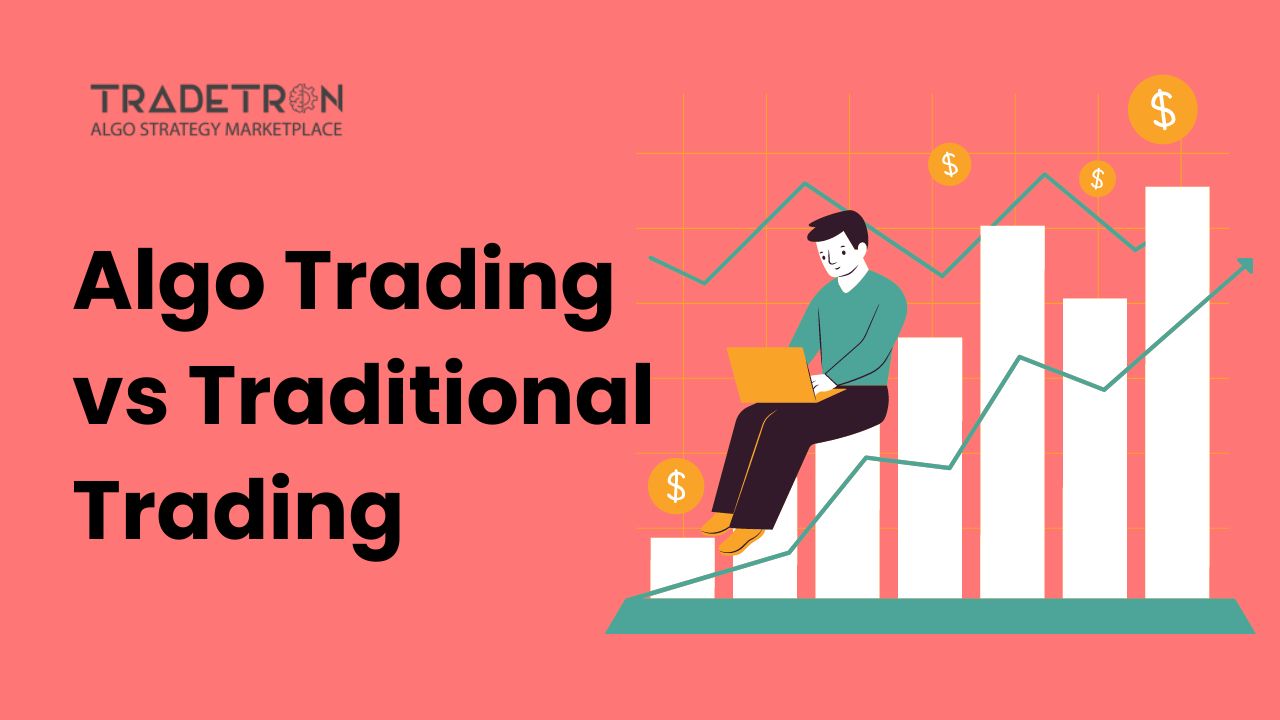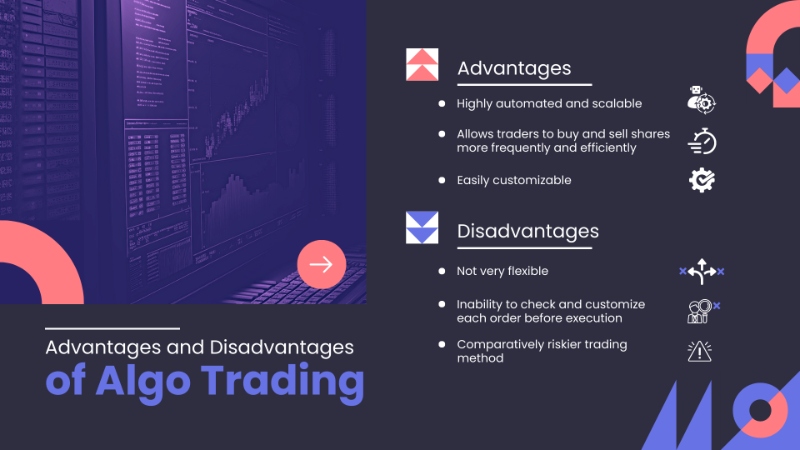Contents
In the world of financial markets, two dominant trading methods have emerged: algo trading and traditional trading.
Both approaches have their unique characteristics, advantages, and challenges.
In this article, we will provide an in-depth comparison of algo trading and traditional trading to help you understand their differences and make informed decisions as a trader.
Global financial markets have often seen unpredictable fluctuations, even in the most stable of times.
That is mostly due to their inherent connection to factors like geopolitics and changing consumer trends.
While these are external factors, some changes in financial markets over the past few decades has been driven partly at least by factors internal to trading environments. Algorithmic trading or algo trading is one such factor.
While the use of computer programs for trading is no longer a new idea, it is certainly one with revolutionary potential.
Algo trading makes trading habits more systematic, leading to increased stock market liquidity.
One of the best ways to get a deeper perspective on algo trading is to analyze how it differs from traditional trading.
While both methods are used to the same ends, they differ in terms of efficiency and investment philosophies.
Let’s understand these differences in practical detail.
What is algo trading?
Algo trading, short for algorithmic trading, involves using computer programs and complex algorithms to automate the trading process.
These algorithms are designed to execute trades based on predefined rules and market indicators, without the need for human intervention.
Algo trading relies on historical data, mathematical models, and statistical analysis to identify trading opportunities and execute orders.
Algo trading is a trading technique where automated computer programs are used to execute trade orders.
These programs are highly-intelligent and powered by complex mathematical algorithms that dictate when and how a trade should be made.
Traders can customize their algo trading strategies according to their investment philosophies and goals.
For example, day traders can set instructions for squaring off positions between 3 and 3.30 PM.
They can use simple time-based triggers to tell their algo trading software to execute trades automatically.
Algo trading works on the basic principle of automating trading-related tasks to place orders more frequently and efficiently. In theory, algo trading can help traders make profits at beyond-human speed and efficiency.
What is traditional trading?
Traditional Trading, on the other hand, is a manual approach to trading where human traders make buying and selling decisions based on their analysis of market data, economic indicators, and other factors.
This method relies heavily on human judgment, intuition, and emotional intelligence when making trading decisions.
Traditional trading is the simple process of buying and selling shares of publicly listed companies.
It aims to make money through the profits earned by selling shares and the dividends paid to shareholders.
Unlike algo trading, traditional trading does not use any automated computer algorithms to make decisions.
Traders have to place each order manually based on their personal discretion.
However, this doesn’t mean that no technology is involved in traditional trading.
Several traditional traders use computer programs to monitor financial markets, spot trends, and place trade orders online.
The only difference here (as compared to algo trading) is that traders have the ultimate authority over each transaction.
Algo Trading vs Traditional Trading

Algo trading differs from traditional trading on several key points.
While the use of technology makes algorithmic trading more efficient, it also makes it less flexible since traders don’t have control over every trade order.
Let’s understand the differences between the two types of trading in detail.
Speed and efficiency
Algo trading is undeniably faster and more efficient than traditional trading.
Algo trading automates the entire process of quantitatively evaluating a stock and placing a trade order against it.
This makes it possible for traders to place hundreds of trade orders at once, which of course, isn’t possible with traditional trading.
Further, algorithmic trading is, at least in theory, more efficient than traditional trading.
Being able to make trade decisions quicker allows traders to trade more stocks and generate higher profits within a set amount of time.
One of the key differences between algo trading and traditional trading is the speed of execution. Algo trading operates with lightning speed and can execute multiple trades simultaneously.
It leverages technology to capitalize on market opportunities instantly.
In contrast, traditional trading relies on human speed and may be prone to delays caused by emotional hesitation or slow decision-making.
Flexibility and customization
Flexibility and customization are a couple of areas in which traditional trading is more effective than algo trading.
While algo trading allows traders to place orders much quicker, computer programs usually place many orders within a very short time.
This makes it almost impossible for traders to monitor each trade and customize it according to their specific investment goals and philosophies.
Comparatively, traditional trading allows traders to retain ultimate control over every trade order, which makes it more flexible.
Risk management
Full automation is a hallmark of algo trading. Once the algorithms are set, they can execute trades with minimal human intervention.
Automation enables swift execution and reduces the possibility of manual errors.
Additionally, algo trading allows for the implementation of complex risk management strategies.
Traditional traders, while having more direct control over risk management, may be more susceptible to emotional decision-making.
Perhaps the most significant drawback of algorithmic trading is that it amplifies investment risks.
This is because of two main reasons:
Algorithmic trading programs usually execute bulk orders.
A predefined algorithm might not be able to make the right decision under unforeseen circumstances.
Since algo trading programs place more trade orders quicker, any losses that you might face on a particular stock are amplified.
These programs are also incapable of the kind of discretion-based decision-making that you might need in times of financial uncertainty.
For instance, let’s say the market price of a stock you have suddenly crashes due to changes in fiscal policies.
Your algo trading algorithm executes a ‘stop loss’ function when the price falls, and all your shares are sold at a significant loss.
Situations like these can only be avoided when a human trader makes the decision to step in and hold on to the shares for some time.
Potential in returns
Algo trading allows traders to invest in mathematically determined shares quickly and efficiently.
This gives it a better potential for returns as compared to traditional trading, where the investment is lesser, but so are the profits.
The high profits usually generated from algo trading can be seen as a reward against the high investment risks it involves.
However, these risks can always be mitigated by creating better, completely optimized trading algorithms that consider every possible scenario.
Backtesting and Optimization
A significant advantage of algo trading is the ability to conduct extensive backtesting and optimization.
Traders can test their strategies using historical data to assess their performance under various market conditions.
This process allows them to refine and optimize their algorithms before deploying them in live markets.
Traditional traders may conduct manual backtesting, but the process is more time-consuming and subjective.
Quantitative Analysis and Subjectivity
Algo trading relies heavily on quantitative analysis and statistical models to drive decision-making.
The approach is data-driven and objective, minimizing subjectivity.
In contrast, traditional trading involves more qualitative analysis, and decisions may be influenced by personal interpretations of market data.
Advantages and disadvantages of each approach
Both algo and traditional trading come with their own unique advantages and drawbacks.
Knowing each of these can help you better understand how and when you should employ each trading method.

Advantages Of Algo Trading
Advantage: Algo trading is a highly automated and scalable trading technique.
The ability to automate the placement of trade orders allows traders to buy and sell shares more frequently and efficiently.
Further, these algorithms can be easily customized to execute higher volumes of trade orders, which makes them very scalable.
Disadvantages Of Algo Trading
Disadvantage: Algo trading techniques aren’t as flexible as most traders would like them to be.
While order automation allows traders to place orders faster, it takes away their ability to check and customize each order before execution.
This lack of flexibility also makes algo trading a riskier trading method.
Advantages Of Traditional Trading
Advantage: It is much easier for traders to mitigate investment risks when they stick to traditional trading methods.
Unlike algo trading, traditional trading allows investors to retain ultimate control over each order that they place on the stock market.
This gives them the space to make intuition-based decisions that aren’t necessarily in line with their investment philosophies.
Disadvantages Of Traditional Trading
Disadvantage: The most pressing drawback of traditional trading methods is that they’re much slower and less efficient than algo trading.
Manually evaluating and placing each order takes time, limiting the potential returns that traditional trading offers.
On the other hand, Algo trading can be used to generate higher returns much more frequently.
Future potential and impact of algorithmic trading
Algorithmic trading is a technique that is actively revolutionizing global financial markets.
It allows both institutional and retail investors to trade at an unprecedented pace and take advantage of the smallest fluctuations in share prices.
It also helps smaller investors trade at many higher-than-expected volumes, naturally making global markets more liquid and stable.
When used well, algo trading programs can be used to trade at a speed and efficiency that are nearly impossible for a human trader to recreate.
With new technological advances being made every day, algo trading algorithms are only expected to become more efficient and inclusive of complex real-world scenarios.
How Tradetron bridges the gap
We at Tradetron actively work towards bridging the gap between algo trading and traditional trading.
The key to this is making algo trading more accessible and easier to grasp for retail traders who might not be as familiar with automation and technology in general.
Our easy-to-use platform allows traders to build and deploy elaborate algo trading algorithms without writing a single line of code.
You can also look for suitable algorithms for yourself at the Algo Strategy Marketplace and invest using tried and tested automation strategies.
Visit us to learn more about who we are and what we do.
FAQs about Algo Trading vs. Traditional Trading
What is algo trading, and how does it differ from traditional trading?
Algo trading, short for algorithmic trading, involves using computer programs and algorithms to automate the trading process.
It relies on predefined rules and market indicators to execute trades without human intervention.
Traditional trading, on the other hand, is a manual approach where human traders make trading decisions based on their analysis and judgment.
What are the key advantages of algo trading over traditional trading?
Algo trading offers several advantages, including high-speed execution, emotionless trading, consistency in following predefined rules, scalability to handle multiple trades, and the ability to backtest and optimize strategies using historical data.
Is algo trading suitable for all types of financial markets?
Yes, algo trading is applicable to various financial markets, including stocks, futures, options, and forex.
The algorithms can be customized to suit the specific characteristics of each market.
What are the main challenges in algo trading?
Some challenges in algo trading include technical complexity in developing algorithms, potential over-optimization, data dependency, and the risk of system failures.
How does emotional bias affect traditional trading?
Emotional bias in traditional trading can lead to impulsive decisions and irrational trading choices.
Fear and greed can influence traders to deviate from their original strategies, leading to suboptimal outcomes.
What role does data analysis play in algo trading vs traditional trading?
In algo trading, data analysis is central to designing algorithms and optimizing strategies.
It relies heavily on quantitative analysis and statistical models.
In traditional trading, data analysis is also essential, but it may involve a mix of quantitative and qualitative approaches.
How does automation in algo trading impact decision-making compared to traditional trading?
Automation in algo trading removes human emotions and biases from the decision-making process, leading to more disciplined and consistent execution.
In traditional trading, human emotions can influence decision-making and introduce potential biases.



 Made with Superblog
Made with Superblog